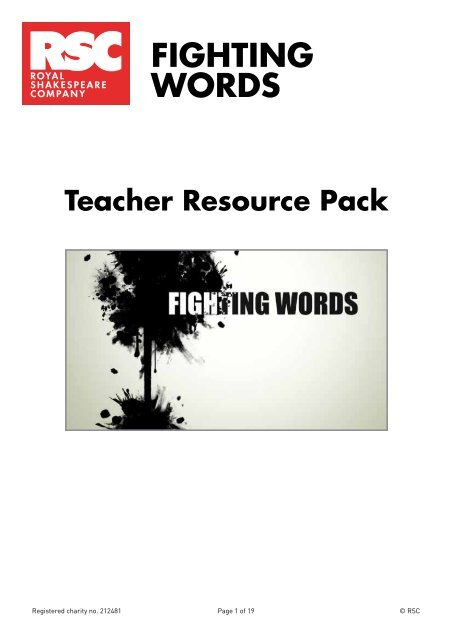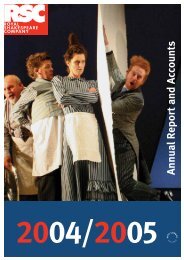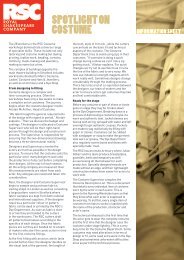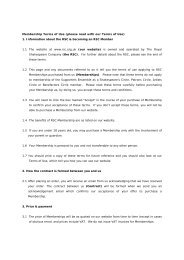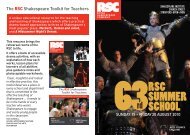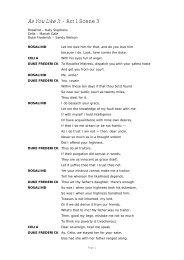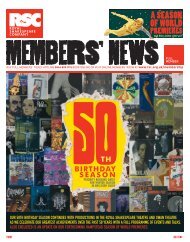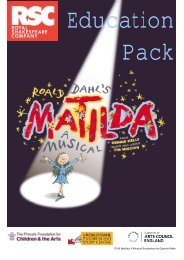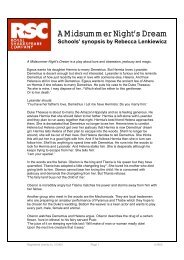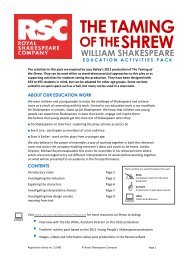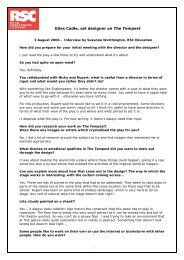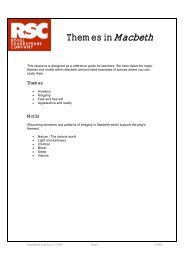Fighting Words - Royal Shakespeare Company
Fighting Words - Royal Shakespeare Company
Fighting Words - Royal Shakespeare Company
Create successful ePaper yourself
Turn your PDF publications into a flip-book with our unique Google optimized e-Paper software.
<strong>Fighting</strong><br />
<strong>Words</strong><br />
Teacher Resource Pack<br />
Registered charity no. 212481 Page 1 of 19 © RSC
<strong>Fighting</strong> <strong>Words</strong> – Teacher Resource Pack<br />
Contents<br />
Welcome and getting started........................................................................................... 3<br />
Resource A: Introduction.................................................................................................. 4<br />
Resource B: Text used in the Introduction (video one)..................................................... 5<br />
Resource C: Verbal Sparring............................................................................................. 6<br />
Resource D: Text used in Verbal Sparring (video two)...................................................... 7<br />
Activities for exploring Act 2 Scene 1 in more detail....................................................... 9<br />
Resource E: Painting with <strong>Words</strong>..................................................................................... 11<br />
Resource F: Text used in Painting with <strong>Words</strong> (video three).......................................... 12<br />
Activities for exploring Act 4 Scene 3 in more detail...................................................... 13<br />
Resource G: Rhyme......................................................................................................... 14<br />
Resource H: Text used in Rhyme (video four)................................................................. 14<br />
Activities for exploring Act 4 Scene 3 in more detail...................................................... 15<br />
Resource I: Writing your Scene (video five)..................................................................... 16<br />
Resource J: Scene Template.......................................................................................... 17<br />
Resource K: Template observation sheet...................................................................... 18<br />
Summary of Materials.................................................................................................... 19<br />
Registered charity no. 212481 Page 2 of 19 © RSC
Welcome and getting started<br />
Welcome to the <strong>Fighting</strong> <strong>Words</strong> Teacher Resource Pack, part of the <strong>Royal</strong> <strong>Shakespeare</strong><br />
<strong>Company</strong>’s online playwriting project for schools.<br />
This project uses <strong>Shakespeare</strong>’s The Taming of the Shrew as a source of inspiration for your<br />
students to write a short scene featuring a man and a woman arguing, cleverly (as they do in<br />
<strong>Shakespeare</strong>’s play). This resource pack will guide you through the online videos and give you<br />
ideas on how your students can write, refine and send in their scene. We will choose the best<br />
entry; if your students are successful, RSC actors will act your scene out and it will appear on<br />
the RSC website!<br />
<strong>Fighting</strong> <strong>Words</strong> has been created in order to:<br />
• provide a brief introduction to The Taming of the Shrew;<br />
• help pupils analyse a range of <strong>Shakespeare</strong>’s writing techniques; and<br />
• encourage pupils from KS3 to KS5 to write a short scene of their own.<br />
This pack is designed to complement the online videos and the Pupil Resource Pack, by<br />
providing ideas for additional activities you might choose to do as your pupils work their way<br />
through the online videos.<br />
You could choose to watch the Trailer film with your students as a way of introducing the project<br />
before embarking on any of the activities.<br />
Who are the people in the online videos?<br />
• Ola Animashawun: Ola is a script editor who has worked with the RSC to create this project.<br />
• Susannah Fielding: Susannah is an actor currently working with the RSC. She plays Kate in<br />
the scenes from The Taming of the Shrew.<br />
• Scott Handy: Scott is also an actor currently working with the RSC. He plays Petruchio in the<br />
scenes from The Taming of the Shrew.<br />
Registered charity no. 212481 Page 3 of 19 © RSC
Resource A: Introduction (video one)<br />
The online videos provide a very brief introduction to the main plot – the relationship and conflict<br />
between Kate and Petruchio.<br />
Further resources, including a longer synopsis, are available on the RSC website. Please visit:<br />
http://www.rsc.org.uk/education/resources/bank/ and select The Taming of the Shrew<br />
This summary appears in the Pupil Resource Pack:<br />
What’s The Taming of the Shrew about?<br />
In brief<br />
• A rich man has two daughters.<br />
• Kate is the eldest. She has a reputation for being rude – a shrew 1 . She has no interest in<br />
being married.<br />
• Bianca is the youngest. By contrast she is quiet and gentle and has several suitors – men<br />
who would like to marry her.<br />
• But Kate and Bianca’s father has said his elder daughter must marry first.<br />
• Petruchio has come as a ‘suitor’ to the ‘shrewish’ Kate. He likes a challenge, but also Kate<br />
comes with a dowry, a sum of money for her future husband.<br />
• Petruchio and Kate argue from the start but they do end up married.<br />
• Petruchio sets out to ‘tame’ his shrewish wife by denying her everything she wants –<br />
but pretending it is out of his love for her.<br />
• The play follows the arguments and conflicts between Petruchio and Kate.<br />
1<br />
A shrew is a small mouse-like creature with sharp teeth. It can also mean a vicious, nagging woman.<br />
Registered charity no. 212481 Page 4 of 19 © RSC
Resource B: Text used in the Introduction (video one)<br />
Act 4 Scene 1<br />
PETRUCHIO: Thus have I politicly begun my reign,<br />
And ‘tis my hope to end successfully.<br />
My falcon now is sharp and passing empty;<br />
And till she stoop she must not be full-gorged,<br />
For then she never looks upon her lure.<br />
Another way I have to man my haggard,<br />
To make her come and know her keeper’s call,<br />
That is, to watch her, as we watch these kites<br />
That bate and beat and will not be obedient.<br />
She eat no meat to-day, nor none shall eat;<br />
Last night she slept not, nor to-night she shall not;<br />
As with the meat, some undeserved fault<br />
I’ll find about the making of the bed;<br />
And here I’ll fling the pillow, there the bolster,<br />
This way the coverlet, another way the sheets:<br />
Ay, and amid this hurly I intend<br />
That all is done in reverend care of her;<br />
And in conclusion she shall watch all night:<br />
And if she chance to nod I’ll rail and brawl<br />
And with the clamour keep her still awake.<br />
This is a way to kill a wife with kindness;<br />
And thus I’ll curb her mad and headstrong humour.<br />
He that knows better how to tame a shrew,<br />
Now let him speak.<br />
Registered charity no. 212481 Page 5 of 19 © RSC
Resource C: Verbal Sparring (video two)<br />
This video focuses on the first exchange between Kate and Petruchio which takes place in Act 2<br />
Scene 1 and looks at how <strong>Shakespeare</strong> uses puns and repetition.<br />
Questions for discussion<br />
We asked these questions in the video. You could choose to explore some or all of them in more<br />
detail with your pupils.<br />
• Why might Kate says she’s called Katherine?<br />
• If Petruchio had called her Katherine, might she have said she was called Kate instead?<br />
Why might she do this?<br />
• What does Petruchio do in return?<br />
• How many times does Petruchio call her Kate? How effective is this repetition? Why?<br />
• What else does Petruchio do in this speech that might annoy Kate?<br />
We have provided the full text on the next page. Text in black shows you the edited version as<br />
it appears in the video and in the Pupil Resource Pack. Text in grey shows you the text we have<br />
edited out for the video.<br />
Registered charity no. 212481 Page 6 of 19 © RSC
Resource D: Text used in Verbal Sparring (video two)<br />
Act 2 Scene 1<br />
Enter Katharina<br />
PETRUCHIO: Good morrow, Kate, for that’s your name, I hear.<br />
KATHARINA: Well have you heard, but something hard of hearing;<br />
They call me Katharine that do talk of me.<br />
PETRUCHIO: You lie, in faith; for you are call’d plain Kate,<br />
And bonny Kate and sometimes Kate the curst;<br />
But Kate, the prettiest Kate in Christendom<br />
Kate of Kate Hall, my super-dainty Kate,<br />
For dainties are all Kates, and therefore, Kate,<br />
Take this of me, Kate of my consolation;<br />
Hearing thy mildness praised in every town,<br />
They virtues spoke of, and they beauty sounded,<br />
Yet not so deeply as to thee belongs,<br />
Myself am moved to woo thee for my wife.<br />
KATHARINA: Moved? In good time! Let him that moved you hither<br />
Remove you hence. I knew you at the first<br />
You were a movable.<br />
PETRUCHIO: Why, what’s a movable?<br />
KATHARINA: A joint stool.<br />
PETRUCHIO: Thou hast hit it: come, sit on me.<br />
KATHARINA: Asses are made to bear, and so are you.<br />
PETRUCHIO: Women are made to bear, and so are you.<br />
KATHARINA: No such jade as you, if me you mean.<br />
PETRUCHIO: Alas! good Kate, I will not burden thee;<br />
For, knowing thee to be but young and light--<br />
Registered charity no. 212481 Page 7 of 19 © RSC
KATHARINA: Too light for such a swain as you to catch;<br />
And yet as heavy as my weight should be.<br />
PETRUCHIO: Should be! should—buzz!<br />
KATHARINA: Well ta’en, and like a buzzard.<br />
PETRUCHIO: O slow-wing’d turtle! shall a buzzard take thee?<br />
KATHARINA: Ay, for a turtle, as he takes a buzzard.<br />
PETRUCHIO: Come, come, you wasp; i’ faith, you are too angry.<br />
KATHARINA: If I be waspish, best beware my sting.<br />
PETRUCHIO: My remedy is then, to pluck it out.<br />
KATHARINA: Ay, if the fool could find it where it lies.<br />
PETRUCHIO: Who knows not where a wasp does wear his sting? In his tail.<br />
KATHARINA: In his tongue.<br />
PETRUCHIO: Whose tongue?<br />
KATHARINA: Yours, if you talk of tails: and so farewell.<br />
PETRUCHIO: What, with my tongue in your tail? nay, come again,<br />
Good Kate; I am a gentleman.<br />
KATHARINA: That I’ll try.<br />
She strikes him<br />
PETRUCHIO: I swear I’ll cuff you, if you strike again.<br />
KATHARINA: So may you lose your arms:<br />
If you strike me, you are no gentleman;<br />
And if no gentleman, why then no arms.<br />
Registered charity no. 212481 Page 8 of 19 © RSC
Activities for exploring Act 2 Scene 1 in more detail<br />
Exploring repetition<br />
• Ask pupils to work in pairs or small groups.<br />
• Depending on age and ability you can either give pupils the edited version of this exchange which<br />
is in their resource pack, or provide them with the unedited version available in this pack.<br />
• Ask pupils to read out loud the exchange. They can either take a character each or read<br />
from punctuation mark to punctuation mark in a circle (so, for example, the first pupil would<br />
say ’Good morrow’; the second pupil would say ’Kate’; the third pupil would say ’for that’s<br />
your name’; and so on. This is quite a useful approach if you have pupils who are nervous or<br />
struggle to read text aloud.<br />
• Ask them to go through the text, in their pairs or groups, and this time underline any word<br />
they can find that is repeated.<br />
• Now ask them to take it in turns to say out loud just the repeated words.<br />
• What do they notice? Why might <strong>Shakespeare</strong> repeat certain words (for example, my, me, you,<br />
thee, tongue, talk, gentleman)? What is the impact of hearing these words again and again?<br />
Exploring puns<br />
With older pupils (because some of the puns are quite sexual) you might like to explore the puns<br />
in the unedited version of the text in more detail.<br />
• Ask pupils to work in small groups of four.<br />
• If they haven’t read the text aloud from the previous activity, ask them now to do so. They<br />
could share the text by two of them together reading aloud Kate’s lines, and two reading<br />
aloud Petruchio’s lines.<br />
• Now ask them to go through the scene again but this time, one is Kate, one is Kate’s<br />
‘pun-partner’; one is Petruchio and one is Petruchio’s ‘pun-partner’. The pupils being Kate<br />
and Petruchio read the scene out loud as normal; the pun-partners call out ‘change’<br />
whenever their character says something that changes the direction of the conversation.<br />
So, for example, at the end of Petruchio’s first long speech he says ’Myself am moved to woo<br />
thee for my wife’. Kate responds with ’Let him that moved you hither Remove you hence.’<br />
Kate’s pun-partner would call out ‘change’ because Kate changes the meaning by talking<br />
about moving/removing Petruchio, i.e. getting rid of him.<br />
• As soon as a pun-partner calls out ‘change’, all four stop and discuss what the pun is – how<br />
has one of the characters deliberately changed the direction of the conversation by changing<br />
the meaning of the word(s) said by the other character?<br />
• Ask them to jot down their ideas and, when the class has finished, ask everyone to share<br />
what they’ve learned about how, and why, <strong>Shakespeare</strong> uses puns.<br />
• Ask them to think further about the puns they might use when they write their scene.<br />
Registered charity no. 212481 Page 9 of 19 © RSC
The post-it note activity<br />
Following one or more of the above activities you could ask pupils to try out the full scene using<br />
the post-it note activity, as the actors do.<br />
• Ask pupils to work in pairs.<br />
• Give each pupil some coloured post-it notes or stickers (each pupil will need a different<br />
colour to that of their partner).<br />
• Ask them to read the scene out loud.<br />
• Every time they think their character has ‘scored a hit’, either through using repetition that<br />
might irritate the other, or through changing the meaning of the conversation by using<br />
puns, they place a post-it note on the other person.<br />
• At the end of the exchange, who has the most post-it notes on them?<br />
• How did the other character win so many ‘hits’? What was their strategy? What techniques<br />
did they use?<br />
Registered charity no. 212481 Page 10 of 19 © RSC
Resource E: Painting with <strong>Words</strong> (video three)<br />
This video explores a scene between the now married Kate and Petruchio where Kate simply<br />
and emphatically pleads to buy a hat she likes and Petruchio deliberately misunderstands her.<br />
It looks at Kate’s use of one and two syllable words, and Petruchio’s use of childish, ‘nonsense’<br />
language. It also invites pupils to start writing their scene, and to consider what words their<br />
characters will choose and for what effect.<br />
Questions for discussion<br />
We asked these questions in the video. You could choose to explore some or all of them in more<br />
detail with your pupils.<br />
• Kate chooses very clear, simple words which are mostly monosyllables. Why is she speaking<br />
so clearly, with such simple words?<br />
• Very occasionally she uses words with more than one syllable: cannot, anger. What impact<br />
do these longer words have?<br />
• Kate repeats certain words and words with a similar meaning: I, babe, child, heart. Why?<br />
• Kate also uses a lot of words about speaking, and listening: Speak, ears, tongue, words.<br />
Why do you think she chooses these words? Why does she repeat some of them? What is she<br />
hoping to achieve? What impact does she want to have on Petruchio?<br />
• Why does Kate say ’I am no child, no babe’?<br />
• How does Petruchio respond?<br />
• Why does he choose to deliberately misunderstand Kate?<br />
• Why does he use nonsense, childish language, like ’a custard coffin’?<br />
• How does this exchange increase the conflict between them? What effect is each hoping to<br />
have on the other?<br />
The text used is available on the next page.<br />
Registered charity no. 212481 Page 11 of 19 © RSC
Resource F: Text used in Painting with <strong>Words</strong> (video three)<br />
Act 4 Scene 3<br />
KATHARINA: Why, sir, I trust I may have leave to speak;<br />
And speak I will; I am no child, no babe:<br />
Your betters have endured me say my mind,<br />
And if you cannot, best you stop your ears.<br />
My tongue will tell the anger of my heart,<br />
Or else my heart concealing it will break,<br />
And rather than it shall, I will be free<br />
Even to the uttermost, as I please, in words.<br />
PETRUCHIO: Why, thou say’st true; it is a paltry cap,<br />
A custard-coffin, a bauble, a silken pie:<br />
I love thee well, in that thou likest it not.<br />
KATHARINA: Love me or love me not, I like the cap;<br />
And it I will have, or I will have none.<br />
Registered charity no. 212481 Page 12 of 19 © RSC
Activities for exploring Act 4 Scene 3 in more detail<br />
Choosing words: the last word of each line<br />
• In pairs, ask pupils to read out loud the exchange from Act 4 Scene 3 (they could take a<br />
character each or read from punctuation mark to punctuation mark).<br />
• Now ask them to take it in turns to read only the last word of each line. So the first pupil<br />
would say ’speak’; the second would say ’babe’; and so on.<br />
• You could ask one pair to repeat this activity for the rest of the class to listen to. What sorts<br />
of words appear at the end of each line?<br />
• Explain to them that <strong>Shakespeare</strong> chooses his words with extreme care and that, when<br />
writing in verse, he not only carefully chooses which words to use but where to put them.<br />
<strong>Words</strong> at the ends of lines tend to stand out. Ask pupils why <strong>Shakespeare</strong> might have chosen<br />
these particular words to end each line.<br />
Choosing words: one word sentences<br />
• Ask pupils to work in pairs or small groups.<br />
• If you haven’t done the above activity, ask pupils to read the scene out loud in their<br />
pair/group.<br />
• In their pair, or group, ask them to go through the scene again, this time with a highlighter<br />
pen. Their task is to choose just one word from each of the thirteen lines, so they end up<br />
with thirteen words. They need to choose words that they feel are likely to have the greatest<br />
impact on the other character – for example, words that clearly express how they feel, or are<br />
most likely to irritate or upset the other.<br />
• When they have chosen their thirteen words, ask one to say out loud Kate’s words and one<br />
Petruchio’s words. You could ask them to come up with a small action to accompany each<br />
word (so, for example, if a pupil chooses Kate’s word “speak” they could cup their hands<br />
around their mouth).<br />
• You could ask some pairs to share their chosen words (and actions) with the rest of the class.<br />
• What words did pupils choose? Why? What did they learn about the exchange between Kate<br />
and Petruchio?<br />
Registered charity no. 212481 Page 13 of 19 © RSC
Resource G: Rhyme (video four)<br />
This video explores a scene between Kate and Petruchio where Petruchio uses rhyme to distract<br />
Kate, thereby ‘winning’ this round in their conflict. It analyses how <strong>Shakespeare</strong> uses rhyme and<br />
invites pupils to incorporate the technique into their own scene. Pupils are also asked to start<br />
thinking about who will win their argument and how.<br />
Resource H: Text used in Rhyme (video four)<br />
Act 4 Scene 3<br />
PETRUCHIO: Kate, eat apace: and now, my honey love,<br />
Will we return unto thy father’s house<br />
And revel it as bravely as the best,<br />
With silken coats and caps and golden rings,<br />
With ruffs and cuffs and fardingales and things;<br />
With scarfs and fans and double change of bravery,<br />
With amber bracelets, beads and all this knavery<br />
Registered charity no. 212481 Page 14 of 19 © RSC
Activities for exploring Act 4 Scene 3 in more detail<br />
Iambic pentameter<br />
• As a whole class, read Petruchio’s speech out loud, together.<br />
• Ask pupils what they notice about the speech? How did it make them feel? They’re likely to<br />
comment on the fact that it’s quite a soft, soothing speech.<br />
• Explain to them that one of the reasons it’s quite soothing is because the first five lines of<br />
the speech adopt the iambic pentameter, a rhythm made up of ten syllables, following a<br />
pattern of five unstressed then stressed beats: unstressed, stressed, unstressed, stressed,<br />
de dum, de dum, and so on. And that this pattern mimics the heart beat, which is why it feels<br />
so comforting and so soothing – after all, what could be more natural than the rhythm of<br />
your own heart beat?<br />
• You could ask pupils to go through the first five lines of the speech again gently tapping out<br />
the iambic rhythm as they say each line.<br />
• Now ask them to try the same with the last two lines? What do they notice? There’s an extra<br />
two syllables. Why? Could it be that Petruchio is getting carried away with himself?<br />
Inventing more and more elaborate distractions? Can they think of any other reasons?<br />
• Ask them to write three or four lines of their own, using the iambic pentameter.<br />
• Ask some pupils to share what they’ve written. How do these lines sound when they’re<br />
underpinned by the iambic pentameter?<br />
Registered charity no. 212481 Page 15 of 19 © RSC
Resource I: Writing your Scene (video five)<br />
Guidance for pupils writing their scenes<br />
After watching the video get students to:<br />
• Create a first draft, using ’Resource J: Scene template’<br />
• Give their draft to two students to read out.<br />
Then:<br />
• Ask the student/s who have written the scene, who are reading the scene and other students<br />
present what works when the scene is read aloud? What doesn’t?<br />
• Ask the student/s if they have chosen the right techniques or do they need to choose again?<br />
• Ask the student/s to redraft the scene in the light of all the feedback that has been given.<br />
• When they’re happy with it, get them to give it to their classmates again.<br />
• If necessary, get the students to do another draft.<br />
• When the students feel that it’s working, film it and send in both their scene and the video.<br />
• If their submission is the strongest, cleverest argument, we’ll get RSC actors to act<br />
it out and it will appear on the RSC website!<br />
To enter the competition pupils need to send in:<br />
A written scene that:<br />
• tells us when and where the scene takes place<br />
• focuses on a source of conflict between one man and one woman<br />
• shows them fighting, with words<br />
• gives us a winner – but they must win through the clever use of words<br />
• uses at least two of the writing techniques that <strong>Shakespeare</strong> used<br />
• is short (no more than two sides of A4)<br />
• uses the template in their resource pack, noting in particular that they must use<br />
Arial font / size 11 / line spacing 1.5<br />
A video:<br />
• of their scene acted out by two of their classmates<br />
• that is no longer than four minutes<br />
In addition, all submissions need to comply fully with the technical specifications and terms and<br />
conditions on our website. We recommend that you check these before submitting. In particular,<br />
please note the following:<br />
• Videos submitted must not identify by name any of the young people involved (i.e. name<br />
badges, etc.)<br />
• Videos and scripts must be submitted by Thursday 24 November 2011 6pm.<br />
• To enter the competition, you will need to email your script to education@rsc.org.uk with<br />
FIGHTING WORDS in the subject title, and upload your video to a private Vimeo.com page.<br />
• To get access to the private page, email education@rsc.org.uk with a request for a<br />
username and password.<br />
• You may enter the competition as a class and/or as individuals or groups within a class.<br />
Each class, individual or group that enters may only submit one entry.<br />
Registered charity no. 212481 Page 16 of 19 © RSC
The below resource is provided in the Pupil Resource Pack for your students to use as a<br />
template:<br />
Resource J: Scene template<br />
Note: your scene needs to be no more than two sides of A4; you need to use the font Arial,<br />
size 11pt; and spacing needs to be 1.5 lines.<br />
Write here, in italics, a very brief summary of where this scene takes place<br />
NAME OF FIRST CHARACTER (IN CAPITALS AND IN BOLD): What they say<br />
NAME OF SECOND CHARACTER (IN CAPITALS AND IN BOLD): What they say<br />
NAME OF FIRST CHARACTER (IN CAPITALS AND IN BOLD): What they say<br />
AND SO ON<br />
Further stage directions can be added in italics<br />
Registered charity no. 212481 Page 17 of 19 © RSC
The below resource is provided in the Pupil Resource Pack for your students to use as an<br />
observation sheet:<br />
Resource K: Template observation sheet<br />
You might want to use this sheet to write down your observations about some or all of the online<br />
videos.<br />
What have I learned about The Taming of the Shrew?<br />
What have I learned about <strong>Shakespeare</strong>’s writing techniques?<br />
Any other observations?<br />
Questions for me to consider/ideas for my scene<br />
Next steps<br />
Registered charity no. 212481 Page 18 of 19 © RSC
Summary of materials<br />
The videos available to support this project, are as follows:<br />
Trailer (2 mins)<br />
A quick taster, inviting pupils to take up the challenge of writing a short scene based on a man and<br />
a woman in conflict, using <strong>Shakespeare</strong>’s The Taming of the Shrew as the source of inspiration.<br />
Video one: Introduction (8 mins)<br />
• A quick introduction to The Taming of the Shrew, the key characters (Kate and Petruchio),<br />
and the actors helping to explore these characters for this project (Susannah Fielding and<br />
Scott Handy)<br />
• A brief description of the writing task<br />
• Next steps: a prompt for pupils to start thinking about the basis of their short scene,<br />
considering who, what, where, when, and why<br />
Video two: Verbal Sparring (7 mins)<br />
• Exploration: of the first exchange between Kate and Petruchio<br />
• Analysis of <strong>Shakespeare</strong>’s techniques: looking at how <strong>Shakespeare</strong> chooses words to<br />
introduce and enhance the conflict between them, particularly repetition and puns<br />
• Next steps: inviting pupils to consider how their couple are going to argue, and the<br />
writing techniques they might use to make the conflict clever<br />
Video three: Painting with <strong>Words</strong> (7 mins)<br />
• Exploration: of a scene between the now married Kate and Petruchio (Act 4 Scene 3)<br />
where Kate simply and emphatically pleads to buy a hat she likes and Petruchio<br />
deliberately misunderstands her<br />
• Analysis of <strong>Shakespeare</strong>’s techniques: particularly Kate’s use of one and two syllable<br />
words, and Petruchio’s use of childish, ‘nonsense’ language<br />
• Next steps: an invitation for pupils to start writing their scene, and to consider what<br />
words their characters will choose and to what effect<br />
Video four: Rhyme (6 mins)<br />
• Exploration: of a scene between Kate and Petruchio (Act 4 Scene 3) where Petruchio<br />
uses rhyme to distract Kate, thereby ‘winning’ this round in their conflict<br />
• Analysis of <strong>Shakespeare</strong>’s techniques: particularly the use of rhyme<br />
• Next steps: an invitation for pupils to use rhyme in their scene, and to start thinking<br />
about who will win the argument and how<br />
Video five: Writing your scene (4 mins)<br />
• A reminder of the task<br />
• Recap on the techniques explored in the earlier films<br />
• Guidance on how to write – and re-write – their scene<br />
Registered charity no. 212481 Page 19 of 19 © RSC


